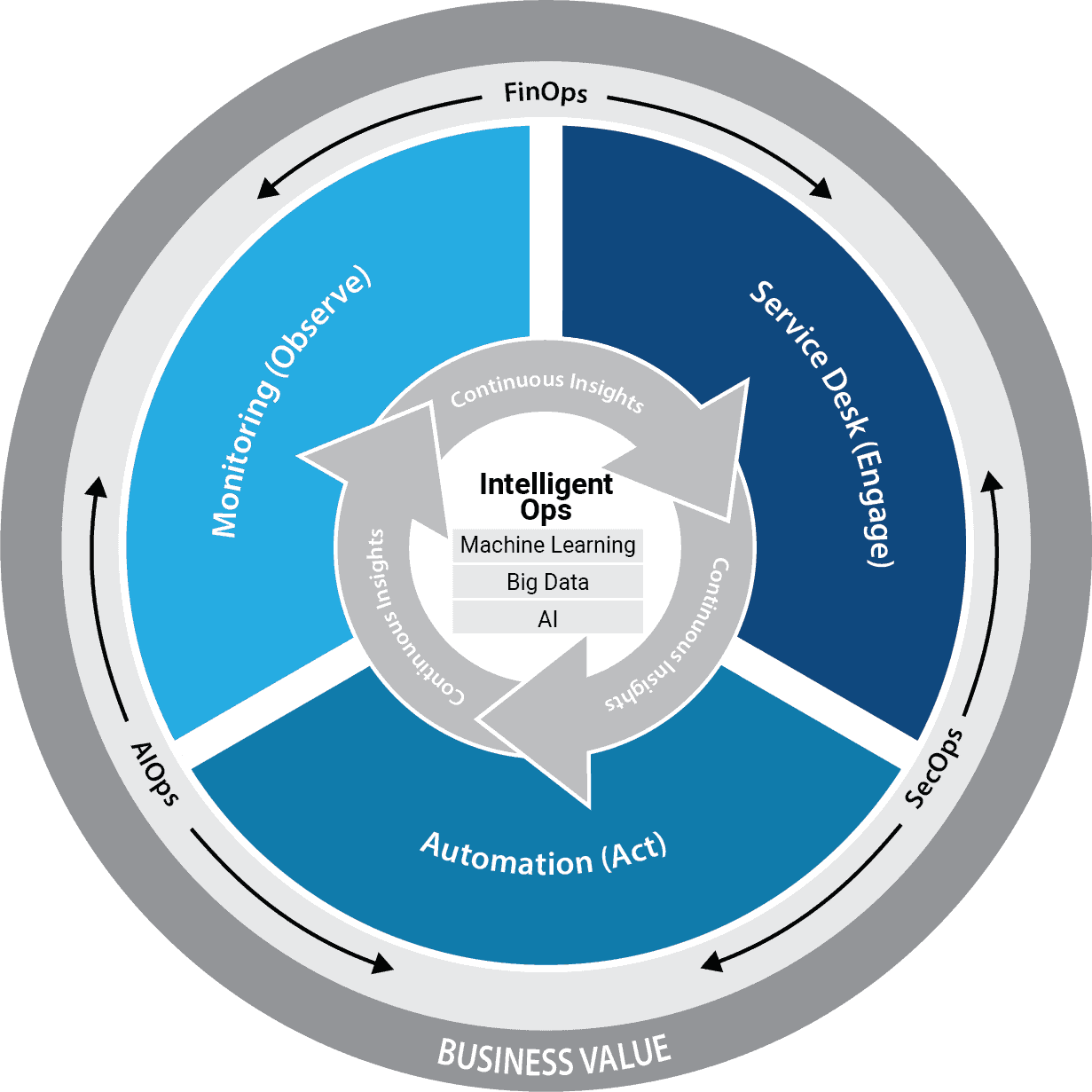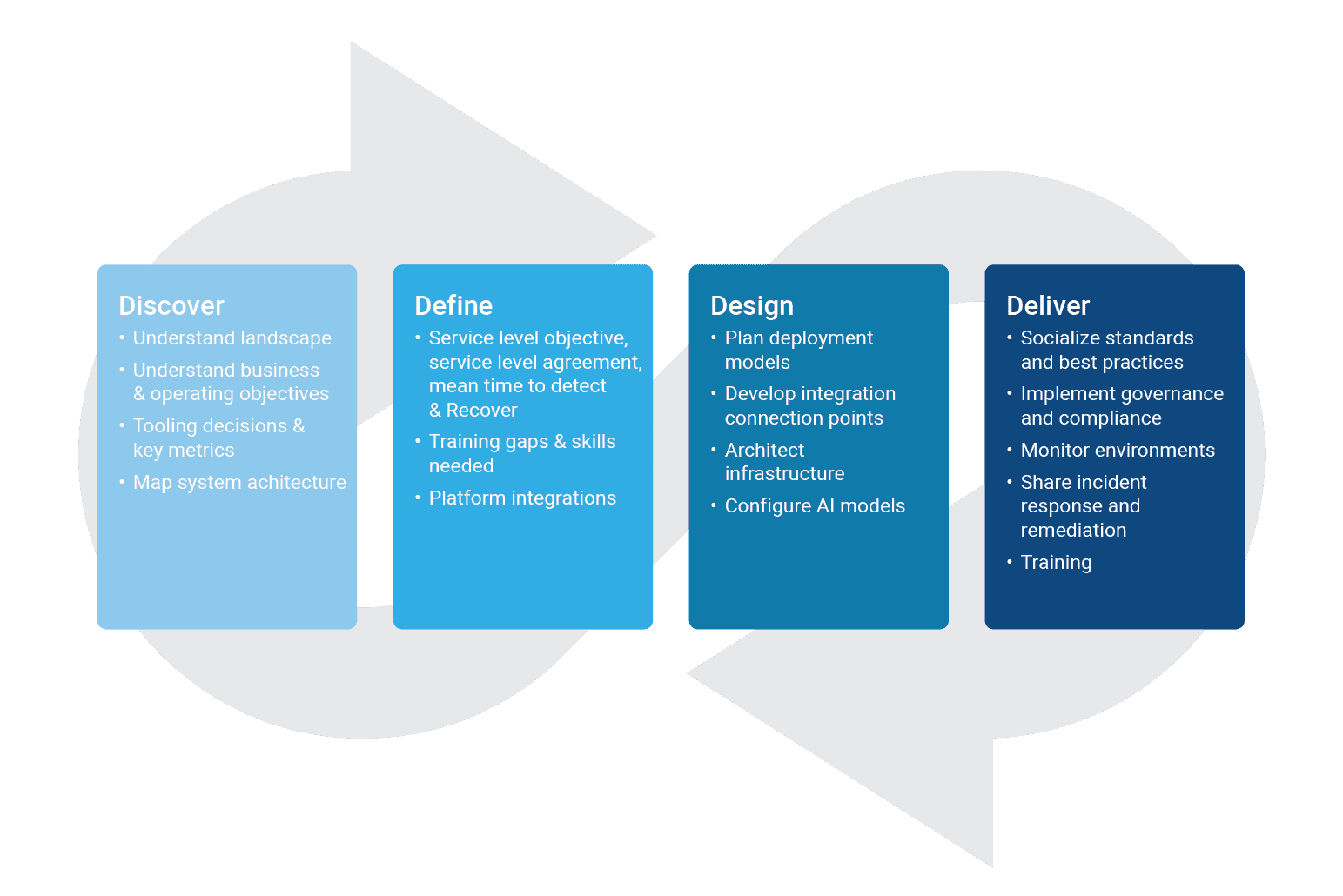The Intelligent Ops Blueprint: Navigating Key Phases
Want to learn more? Dive deeper with our comprehensive Intelligent Ops guide.
Actualizing the value of Intelligent Ops takes careful preparation, planning, and implementation. In this blog, we’ll explore some of the things your organization can do to set itself up for success.
What is Intelligent Ops?
Intelligent Ops represents the next evolution of AIOps, utilizing cutting-edge technologies like generative AI to bolster the entire business. It expands on the conventional understanding of AIOps, encompassing three primary pillars:
- AIOps: Offers precise visibility and control over IT infrastructure and incident management through integrated, intelligent monitoring.
- FinOps: Lowers the total cost of ownership (TCO) by relying on strategic, data-informed recommendations and smart optimization.
- SecOps: Enables quick threat detection and resolution by integrating AI, cloud computing, and automation.

A mature Intelligent Ops strategy can streamline operations, decrease the Total Cost of Ownership (TCO), and elevate the customer experience. However, many organizations hit a snag due to a lack of clarity on how to embark on the Intelligent Ops journey.
Key Elements for a Successful Intelligent Ops Implementation
To effectively implement Intelligent Ops, it's crucial to comprehend the multifaceted elements of an operations program. These elements can be categorized into business, technological, and administrative domains.
Build consensus and the business case for Intelligent Ops
As discussed, a successful Intelligent Ops program holistically supports the business. Intelligent Ops expands beyond AIOps, integrating SecOps and FinOps to complete your operational journey.
From the business standpoint, two pivotal prerequisites for implementing Intelligent Ops are the backing and consensus of key stakeholders, and an organizational readiness to transition into modernized operations.
To bridge the gap between understanding and action, we strongly recommend crafting a compelling business case for Intelligent Ops. Engage with department leaders, highlight the tangible benefits, and showcase how Intelligent Ops can address specific pain points within the organization. By presenting a clear vision and tangible outcomes, you can rally the support needed to make Intelligent Ops a foundational element of your business operations.
Foster stakeholder engagement
Intelligent Ops is crafted to bolster the business side of IT. This necessitates endorsement and backing from the C-suite, ensuring operational directives are in sync with the company's overarching vision and trajectory. It's at this echelon that the diverse facets of Intelligent Ops — including financial and security objectives — are established, guiding operational teams to shape the business facet of IT.
Adopting an Intelligent Ops mindset
Optimizing the business isn't just about efficiencies in isolated processes; it's about looking at the organization holistically, understanding how different elements interact, and identifying areas where innovation can drive significant value. While AIOps plays a crucial role in streamlining and automating processes, Intelligent Ops delves deeper. It harnesses the power of AI and advanced instrumentation, not just to automate but to provide actionable insights. It prompts leaders to ask forward-thinking questions like, "How can we leverage technology to make our operations more efficient, secure, and cost-effective?" or "Where are the untapped opportunities for innovation in our current operations?"
By fostering this Intelligent Ops mindset, organizations position themselves to be more resilient in the face of challenges and more adept at seizing opportunities in the ever-evolving tech landscape.
Technical Alignment
Intelligent Ops taps into contemporary technology to augment business operations. Technologically, an organization requires specific infrastructure, components, and a diverse skill set to cultivate a potent Intelligent Ops program.
Components and Infrastructure
An Intelligent Ops program bifurcates into the system(s) under governance and the Intelligent Ops platform overseeing the management. Several prerequisites for this category include:
- Baseline: A foundational configuration or a reference group, essential for measuring enhancements and the ramifications of various modifications.
- Target: A system receptive to the directives of an Intelligent Ops platform.
- Data: The capability to amass data (logs, alerts, etc.) from the governed system and to retrieve historical, real-time, and forecasted data.
- Deployability: The proficiency to roll out one or multiple units of the system under management, along with AI models to navigate and assimilate the system's behavior.
Upon pinpointing the system(s) necessitating management, the organization can embark on designing, constructing, and launching an Intelligent Ops platform for its oversight. This venture calls for a comprehensive architectural blueprint, coupled with access to an assortment of tools, components, and foundational elements, vital for instituting various management and surveillance functions.
Technical skills
To design, implement, and operate an Intelligent Ops program, you need deep expertise across several domains. The essential skill sets include:
Data Science and Engineering: Customizing an Intelligent Ops program for business needs demands the capacity to create, test, and refine AI models. Data scientists and engineers play crucial roles in collecting and formatting input data, and in developing the models that monitor and manage an organization's systems.
Systems Architect and Administrator: Intelligent Ops platforms monitor and manage intricate IT landscapes. Systems architects and administrators are indispensable for designing the overarching system and ensuring its ongoing functionality.
Cloud Engineers: Intelligent Ops enhances cloud operations by collecting data, processing it, and employing various tools to effect changes. Comprehensive cloud knowledge is vital to craft and maintain the interface between the Intelligent Ops platform and the cloud infrastructure.
Business Analyst: These professionals are crucial to delineate the business processes that the Intelligent Ops platform will automate, monitor, and manage. Each process must be charted from start to finish, with metrics that determine its success or failure.
A successful Intelligent Ops rollout also demands the establishment of specific processes to buttress the program. As Intelligent Ops quickens the tempo of IT operations, many of these processes revolve around change and knowledge management.
Stages of Implementing Intelligent Ops
Implementing Intelligent Ops involves leveraging generative AI to revamp an organization’s IT management. To help mitigate risks and hasten the realization of value for an Intelligent Ops program, Neudesic uses the 4D development framework; however, the following can be adapted to almost any existing process.
1. Discover
For Intelligent Ops to be successful, it must be tailored to an organization's unique needs. The Discovery phase ensures this alignment:
- Understand the landscape: Familiarize with the existing tools, ensuring proper monitoring and controls are in place.
- Business and operating objectives: Document and prioritize the business goals for the Intelligent Ops program. This acts as a roadmap for teams, helping them understand dependencies, make informed decisions, and move more swiftly. It's a vital tool to prevent undesirable outcomes and speed up time-to-value.
- Tooling decisions and key metrics: Using insights from the landscape and goals, decide on the required tools and define success metrics.
- Map system architecture: With defined goals and systems, draft a high-level system architecture for the Intelligent Ops program.
2. Define
Building on the discoveries:
- Metrics and commitments: Set Service Level Objectives and Agreements (SLOs and SLAs) and decide on Mean Time to Detect and Recover (MTTD and MTTR) metrics, based on business needs and system architecture.
- Training and skills: Identify and bridge any training or skill gaps after comparing the organization’s current capabilities with its Intelligent Ops objectives.
- Platform integrations: Define the integrations needed with platforms like Microsoft Azure for optimal monitoring and remediation.
3. Design
The Intelligent Ops program revolves around three pillars: AIOps, FinOps, and SecOps. This stage focuses on crafting solutions that cater to business needs in these areas:
- Plan deployment models: Outline strategies for deploying Intelligent Ops within the organization.
- Develop integration connection points: Define interfaces for integrating the Intelligent Ops platform with existing IT and security systems.
- Architect infrastructure: Plan the Intelligent Ops infrastructure's placement within the broader IT landscape.
- Configure AI models: Detail the AI models required, such as anomaly detection and predictive maintenance.
4. Deliver
This concluding phase involves the actual implementation and support of the Intelligent Ops components:
- Socialize standards and best practices: Create reference architectures, reporting standards, and best practices for systems under management.
- Implement governance and compliance: Establish governance criteria, including documents and Azure platform policy definitions, to ensure ongoing operational improvements.
- Monitor environments: Highlight essential elements for efficient operations, such as native Azure implementations, monitoring standards, and third-party tool and security integrations.
- Share incident response and remediation: Draft policies and procedures for incidents managed by the Intelligent Ops platform, with clear metrics like MTTR.
- Training: Equip users with the knowledge they need to fully harness the Intelligent Ops program.
Intelligent Ops with Neudesic
Building an Intelligent Ops program can be a significant undertaking. To be successful, an organization needs a clear understanding of its infrastructure and goals for the program as well as a wide range of subject matter expertise. Many organizations may not have the required skills, expertise, and resources in-house.
The Neudesic Intelligent Ops Accelerator creates an easier and faster path to a mature Intelligent Ops program. Neudesic has deep expertise in leveraging AI to support the business, as demonstrated by its title of Microsoft’s US AI Partner of the Year (POTY) for 2023. With Neudesic’s proven processes, tools, and components, organizations can more quickly implement a valuable and sustainable Intelligent Ops program.
